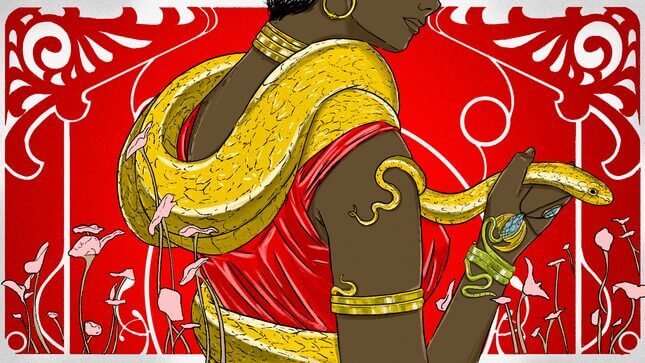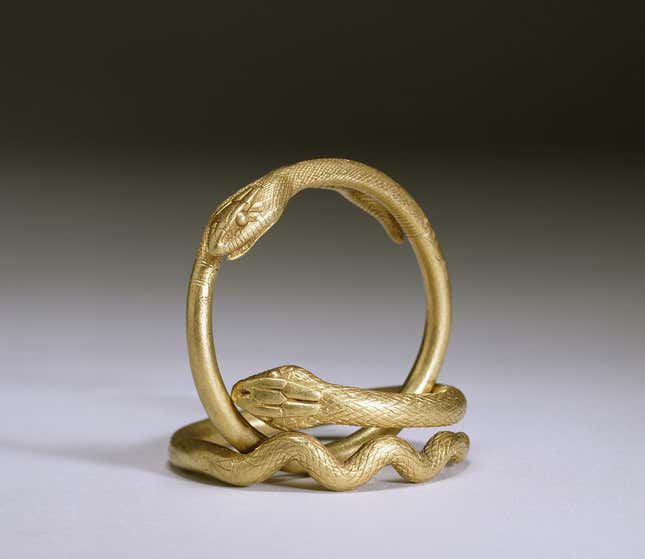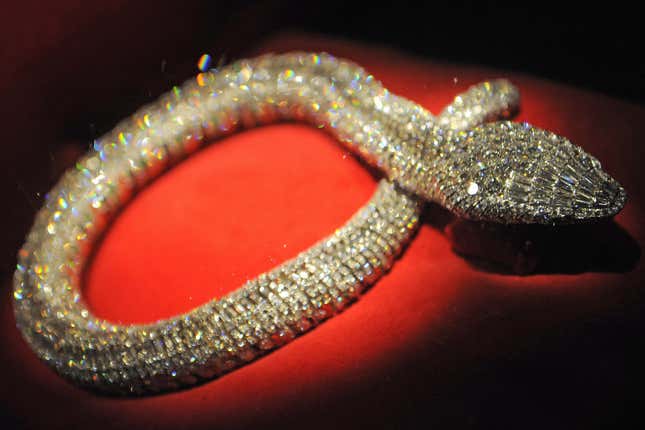The Timeless, Twisty Appeal of Snake Jewelry
In Depth
Image: Benjamin Currie/G/O Media
Neither the actress nor the character liked the outfit, but that didn’t matter. It was the early 1980s, and Carrie Fisher wasn’t quite a household name. She was famous, certainly, and she had been acting for years, but very few actresses got to choose what they wore on-screen, especially back then. When George Lucas showed her the outfit, she “thought he was kidding,” she later said. She called it “what supermodels will eventually wear in the seventh ring of hell.” Although already thin, Fisher was pressured to lose weight in order to wear the gold bikini with the gold metal snake armbands and the gold chains. (Lucas “didn’t want any creases” to show in her sides, because god forbid a leading lady have skin that moves like a human.) She wore the bikini for just three minutes of screen time, but the outfit became famous. It was so rigid, so confining, so fantastical, so beautiful.
I do think it’s beautiful. I can’t help it. When I remember what it symbolizes—a tough woman held captive, both onscreen and off, by male expectations and an amorphous extraterrestrial sexpest, respectively—I love it less. But the look itself is timeless; it exists outside time. The outfit could have come from a futuristic runway show or an ancient Pompeian brothel.
This is due, in part, to the ubiquity of snake jewelry and serpentine iconography across history. Humans have a thing about snakes. Maybe it’s because they’re so easy to draw. Or maybe it’s because their bodies are so fundamentally unlike ours, their movements so foreign. Either way, we’ve been dressing in snake armbands and necklaces, snake earrings and engagement rings, since practically the dawn of jewelry.
I know this because I’ve spent the last two years searching for the perfect snake ring. Inspired by an increased presence of snakes in my backyard (her name is Esmeralda, and she may be many small green snakes, but I chose to believe she’s one queenly lady), I started looking for snakes. First, I started looking online for gold ones, and I wound up at Mejuri contemplating their small gold number and cruising Erica Weiner for their antique-inspired coils. Then, I started looking for dreamy serpent-bedecked dresses, like this vintage Halston number or this slinky Roberto Cavalli one-sleeve or this glamorous Gucci embroidered tulle gown. Eventually, I started seeing snakes everywhere. They were in ads targeted towards me, snake jewels and snake clothes. They were also out on the trails, slithering away in the sand between the pines, lying in wait on top of warm stones, copulating in old stonewalls. Like the Hot Priest in Fleabag followed by foxes, I began to suspect that I was being trailed by serpents. That led me down another rabbit hole (or snake hole?) and even as I doubted my own sudden snake-sight, I began to earnestly research the symbolism of the snake.
Fittingly, snakes wiggle in and out of stories and cultures, in and out of associations and meanings. You can’t pin those fuckers down. Unlike the elephant, which is associated with memory and longevity and good luck, or the fox, known for its wiles and predation and speed, the snake can mean pretty much anything. Growing up Catholic, I’ve always been familiar with stories about the snake as the devil. Snakes, I learned rather passively, were creatures that could lie and slither and seduce—like women. In one of my favorite childhood books, The Silver Chair by C.S. Lewis, some kids go to Narnia and they find the land tormented by a shape-shifting woman in a green gown, an emerald witch who can turn herself into (what else?) a tiny green snake. I knew of Medusa, that man-killer with her head of snakes. I knew of Saint Patrick and his miracle cure of Ireland from the scourge of snakes.

But I didn’t know Medusa was a rape victim, and I didn’t know Narnia was a deeply religious text that borrowed entire plotlines and characters from the Bible. I didn’t know that Ireland was snake-free for the same reason that Iceland is—it’s a cold island, too cold for most cold-blooded creatures. And I didn’t know that Queen Victoria, in 1839, at the age of 16, received a serpentine wedding ring from Prince Albert. I didn’t know that Victorians were all about that snake jewelry. I had no idea that, for many people around the globe, including many Christians, snakes symbolized more than just temptation. They were signs of eternal love, ever-renewing, ever binding.
While some historians suggest that Prince Albert kicked off the snake jewel trend, that’s not exactly the whole story. Victoria already had several snake-shaped pieces in her jewel box, and the trend had been building for a few years before they became engaged. Albert knew her style, and it seems that he was very good at giving gifts. She cherished his presents long after his death. For the engagement, he picked out a gold serpent that wrapped around the finger once, overlapping head and tail, with a central emerald stone (Victoria’s birthstone) surrounded by small flush-set ruby eyes and diamond accents. While it would be out of place at most weddings today, it wasn’t strange at the time to have an engagement ring that featured birthstones more prominently than diamonds. The South African diamond mines had yet to be discovered and drained, the iconic De Beers “A Diamond is Forever” ad campaign was still a century away, and it was pretty normal to get engaged with a slightly more subtle, personal ring.
Fittingly, snakes wiggle in and out of stories and cultures, in and out of associations and meanings.
Serpent jewelry became fashionable in Europe in the 18th century, thanks in part to the nobility’s continued fascination with terra incognita and the people who lived there. In the non-white world, snakes weren’t viewed as devilish or disgusting. It was normal to fear them, certainly, but the fear came with respect and admiration, not necessarily repulsion. According to The Book of Symbols, the snake has long been linked to the “secret, subterranean, oracular mysteries of knowledge” and “always conveyed power of life and death, making it everywhere a form of the ancestral spirit.” According to Egyptian mythology, snakes were immortal and could shed their skins again and again, emerging fresh and young ad infinitum. What luck! People have always wanted to be able to shed their old skins, becoming new and better versions of themselves. How else can you explain the annoying proliferation of “New Year, New You” content that appears without fail come January 1st? I suspect that humans have always been a bit jealous of snakes, envious of their ability to leave the discarded husks of their outward-facing personas behind and slither gaily on the earth.
Being linked to the process of birth also meant snakes were often linked to the mother goddesses. Despite their phallic shape, snakes are often seen as female in spirit, and some cultures even believed that snakes were able to regenerate only if given access to menstrual blood. Both men and women have worn snake jewelry, but in the modern era, these twisty emblems tend to be wrapped around female-identifying forms. And when the right woman dons a serpent, the effect is nothing short of iconic.
I was a pre-teen when Britney Spears burst out of a wavy-barred cage on the stage at the MTV Music Awards and began dancing with a live snake. Although it wasn’t a piece of jewelry, Britney wore it like one, with the ease of a Minoan goddess (though without the breast-baring dress). Before Britney, there was Maria Félix. A Mexican movie star from the 1950s, she supposedly refused to learn English because she didn’t want to appear in Hollywood films, though she was perfectly willing to learn French to be a part of their cinematic tradition. Félix was known in the English-speaking world, in part, for her decadent jewelry. She wore bejeweled crocodiles and panthers, but her favorite emblem was the snake. After decades of appearing in public dressed in snake bracelets and earrings, in 1966 she walked into the Cartier flagship store in Paris and commissioned what was to become her most famous piece of jewelry: a life-sized snake necklace. The finished piece took two years to make and was covered from head to tail in 2,473 diamonds. It was fully flexible and unlike anything Cartier had made before or since.

But before Britney and Maria and Aaliyah and Taylor Swift and Elizabeth Taylor and Carrie Fisher and the hundreds of other women who have appeared on screen with serpents highlighting their lines and curves, there was Sarah Bernhardt. Sarah Bernhardt is the reason I never found my perfect snake jewel, because it does exist but I cannot have it. Designed by Czech artist Alphonse Mucha and constructed by French jeweler Gorges Fouquet in 1889, the piece is an incredible example of art nouveau style, created for the actress to wear on stage to play the tragic, violent figure of Medea, who died of an adder bite after going scorched earth and killing her entire family and then some. The item in question is a green-scaled enamel bracelet with a gold underside that coils around the wrist before resting its winged head (covered in opals, rubies, and diamonds) on the back of the hand. This large snake is linked by small, delicate chains to a second snake that Bernhardt wore as a ring. Bernhardt’s talent inspired Mucha to create this, and many other works. She was a star.
Also, like too many stars, Bernhardt burnt out and fell. She lost her fame, she lost her money, she lost her health and her looks. She sold her jewelry off, piece by piece, including those perfect slithering green snakes. Unexpectedly, the piece wound up in a museum in Japan dedicated to Mucha’s works. It now resides under glass. I imagine it will stay there for the time being, or until some star or another gives it new life on a red carpet, because jewelry is made to be worn, to be warm against skin. I can only hope.